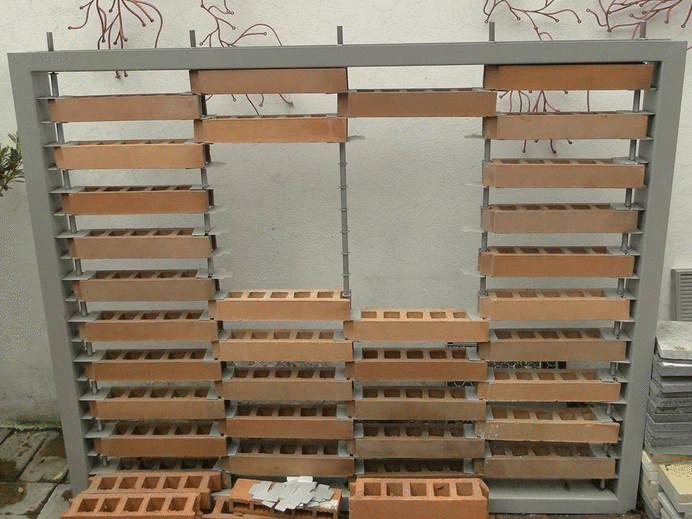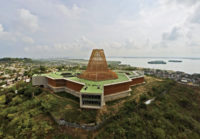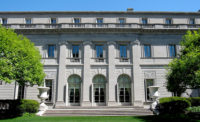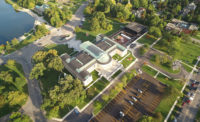The first chapter of Gabriel García Márquez’s feverish novel Of Love and Other Demons closes with a prescient word of wisdom. After a physician examines a nobleman’s daughter feared to have contracted rabies, he prescribes a regimen not of elixirs, but of flowers, birds, and views to the setting sun. “No medicine cures what happiness cannot,” the doctor advises.
Such a philosophy is at the heart of a recent expansion of Bogotá’s Fundación Santa Fe hospital by Colombian architect Giancarlo Mazzanti, where lush interior gardens combined with vistas of the jagged Andean hills give recovering patients a sense of freedom and hope.
Additional Content:
Jump to credits & specifications
“When you are here, you are no longer inside the building, you are outside of it,” says Mazzanti, standing in the hospital’s verdant interior garden. “We wanted to bring new possibilities to the patients and the people inside.”
Nature has been integral to Fundación Santa Fe’s mission since it was established in 1972. The founders envisioned a nonprofit medical institution that would be at the forefront of research and patient care, while shunning the antiseptic feel of a status quo hospital. Accordingly, the building’s architect, the American modernist George Nelson, designed the hospital to be “the Colombian Garden of Health.” An X-shaped structure constructed from local brick, the hospital included tree-shaded gardens, an airy atrium, and rooftop plantings.
Over the decades, Fundación Santa Fe became one of Colombia’s premier medical institutions, boasting achievements like the country’s first heart transplant and partnerships with institutions like the Universidad de los Andes and Johns Hopkins University. But in recent years, it faced overcrowding, and its aging facilities lacked the flexibility to keep up with changes in medical technology. What’s more, a series of expansions left the facility a gloomy jumble that strayed from Nelson’s original vision.
Mazzanti, in a competition-winning design, proposed an extension that would promote a sense of connectivity throughout—physical and ideological links to the original building, the community, and nature. The resulting facility (inaugurated last November)—a 12-story cube set atop a single-story podium and rotated 45 degrees—provides the northernmost anchor for the complex and a new landmark for a bustling site in Bogotá’s Usaquén district, a mixed residential and commercial quarter.
Driving north on Carrera 9, where motorcyclists careen through a steady stream of cars, the new building emerges from behind Nelson’s modernist structure. In spite of the addition’s monumental massing, it is airy and delicate, thanks to an innovative brick veil made from the tawny masonry that characterizes the old building and Bogotá’s larger urban fabric. “Everything in the existing complex was brick,” explains Mazzanti. “I wanted to work with it—but in another way.” The Mazzanti team developed an ingenious system of thin, hollow bricks clipped onto cables like beads on a necklace, to screen the steel-and-concrete building, as well as to provide sunshading and, through a variety of apertures, frame views. The brick weave— loose in some areas, compact in others—creates varying degrees of transparency and opacity. A large concave depression and ribbon windows incise each facade, further adding texture to the four exposures.

A model of the brick screen. Animation courtesy of El Equipo Mazzanti.
The architects sought to promote openness not only with the facade but with a public plaza that allows the community to approach the building—a difficult task given that the hospital hosts high-security patients, ranging from dignitaries to prisoners. But they convinced the hospital to include a landscaped plaza on top of the podium, accessed by stairs leading up from the sidewalk. It provides a respite between Carerra 9 and Carrera 7, two of the city’s busiest thoroughfares.
This terrace also provides a visual and physical connection to the hospital’s interior. A circular void cuts through the platform, creating space for a glass-enclosed garden below and bringing sunlight and greenery into the main lobby. Within this double-height reception and waiting area, accessed by street-level entrances, the team established crucial connections to the existing lobby, two stories above, via a series of stairs.
Elevators carry visitors to the main medical floors, which include levels for intensive care, surgery, neonatology and obstetrics and gynecology. The neurology floor on level 7 also includes an auditorium and staff lounges. Each floor is organized in rings: the outermost corridors lead to patient-treatment and recovery rooms, the middle are for staff, and the innermost spaces conceal back-of-house functions such as food service and waste removal.
For the design of the patient zones, says Mazzanti, “We wanted to create a relationship with nature and with the city, and also a feeling of being in a kind of hotel instead of a hospital.” This often came down to smaller design moves. Within hallways, for instance, the architects located lights to the side to keep the glare out of the eyes of patients on gurneys. The individual rooms are double or triple the size required by Colombian code. Ribbon windows are located at bed level, allowing patients to have unobstructed views to the city’s red tile roofs and out to the Andes beyond.
On the sixth floor, in the neonatal unit, each family has its own private glass cubicle—24 in all—in lieu of archetypal nurseries with rows of incubators. According to Dr. Juan Gabriel Piñeros, head of this department, the hospital plans to conduct a study to determine how the new facility is affecting health, but he is already noticing improvements in both infection rates and staff morale. “It’s a dream come true,” he says. “The success of the project is that it’s a project made by everybody.” Before embarking on the design process, the architects solicited input from employees ranging from physicians to the janitorial staff. For instance, catwalks between the brick screen and the building envelope facilitate maintenance; concealed cabinetry allows for contained waste disposal to reduce cross-contamination; spacious staff lounges and cafés feature areas to relax, and stunning vistas. “When your working conditions improve there is also a change of attitude—there is less fatigue, more big smiles,” says Mazzanti.
Nowhere is this more apparent than in an interior garden at the top of the building, where the architects created a four-story indoor jungle within a cavity between the building’s brick screen and concrete walls. Here, a path meanders through a grove of palms and ferns, while vines spill from hanging planters. The city flickers through the perforated screen like a filmstrip. Oxygen connections enable sick patients, otherwise confined to their rooms, to feel fresh breezes. It’s tranquil here; on a recent afternoon, a patient in a wheelchair, with a caretaker, took in the quiet and peace.
Going forward, the patients will sustain the garden, just as it sustains them. According to Mazzanti, each family will receive a plant at the beginning of the patient’s stay, to be cared for over the course of treatment. Before residents return home, they will replant it in the solarium—an enduring symbol of healing.
CreditsArchitect: El Equipo Mazzanti — Giancarlo Mazzanti, Sebastián Negret, Fredy Fortich, Alberto Aranda, Felipe Pombo, Rocío Lamprea, César Grisales, Trinidad Guzmán
Interior designer: Solinoff Corporation
Consultants CNI Ingenieros, PYP (structural); Groncol (landscape); Carmenza Henao (lighting); Diebold Colombia (security)
General contractor: Payc
|
SpecificationsStructural system Argos, Diaco
Masonry Argos
Glass Ventaner
Elevators OTIS
Furnishings Contract SA, Herman Miller, Solinoff Corporation
|


























Post a comment to this article
Report Abusive Comment